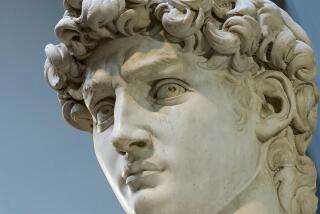Court Deals a Blow to Getty Quest for ‘Graces’ : Art: Decision in London may end the long complicated battle for possession of the 19th-Century sculpture by the Venetian artist Canova.
LONDON — A British court on Thursday rejected a key legal maneuver by the Getty Museum to win possession of “The Three Graces” by Italian sculptor Antonio Canova.
The Los Angeles museum had challenged a decision by Stephen Dorrell, national heritage secretary, giving local donors more time to raise money to buy the statue and keep it in Britain.
John Russell, a London spokesman for the Getty, said the ruling Thursday by the Court of Appeals was “the end of the line,” as this matter now may not be taken higher--to the House of Lords.
“You cannot go further than this,” he declared. “We are naturally very disappointed. Everybody knows the museum has been treated unfairly but that was not a matter of concern for this court.”
*
Russell added that the Getty would “now review its policy on the buying of works of art in this country. . . . The trustees have always had faith in the export license system here. This whole thing about ‘The Three Graces’ demonstrates perhaps that that faith has been misplaced.”
Getty trustees successfully bid 7.6 million--more than $12 million, especially considering the appreciation of the British currency against the dollar--for the noted 19th-Century sculpture, which, after an initial deadline had passed, British museums raised a matching sum to keep here.
Thursday’s decision seems to end a long, complicated battle for possession of the work by the fashionable Venetian artist Canova.
He was commissioned to create “The Three Graces” by the Duke of Bedford in 1815. The sculpture, depicting the three daughters of Jupiter, arrived at the family seat, Woburn Abbey, in 1819. It remained there in relative obscurity, until a descendant, the Marquess of Tavistock, strapped to pay taxes, offered to give the statue to Britain in lieu of taxes. That offer was turned down.
Instead, the piece was purchased in 1985 by an off-shore company based in the Cayman Islands, which, in turn, agreed in 1989 to sell it to the Getty.
British art authorities, however, objected to seeing this country lose “The Three Graces,” arguing that it was of such noteworthy quality that the nation’s cultural heritage would be diminished by its loss; experts here also decried the loss of Britain’s artistic treasures to wealthy, foreign buyers.
British museum directors sought to raise a matching sum to keep “The Three Graces” in this country. But they failed to do so. Earlier this year, then-Heritage Secretary Peter Brooke delayed for six months the granting of an export license to the Getty while the British institutions sought additional funds. They were unsuccessful again.
When the money was not raised, at the request of the British museums, Dorrell--Brooke’s successor--overturned government rules and extended the export permit’s delay for three more months, while institutions here scrambled to find donors to buy the work.
John Paul Getty II, an Anglophile and the philanthropist son of the Los Angeles museum’s founder, then stepped in, pledging 1 million ($1.5 million) toward a matching fund to keep the sculpture here. Getty subsequently threatened to withdraw his support, temporarily angered by comments by the director of the Scottish museum about his relations with his father. But Getty relented after he received an apology.
His support for the cause was joined by Baron Heinrich von Thyssen, one of Europe’s wealthiest men, who pledged the final 800,000 ($1.2 million).
Getty lawyers, arguing that the last British export license extension was “irrational and unreasonable,” began legal proceedings, which previously were rejected in a lower court.
The three-judge appellate court on Thursday rejected Getty arguments that the Southern California institution had a “legitimate expectation” to the statue and that the first, six-month delay of the export license should have been the last.
The British fund-raising effort to keep “The Three Graces” was led by the Victoria and Albert Museum in London and the National Gallery of Scotland, both of which plan to display the Canova sculpture.
Their directors solicited the younger Getty and Thyssen for their support.
A spokesman for the Victoria and Albert said late Thursday: “It is a bit premature for celebration. We still have to negotiate with the owners to actually buy the statue outright.” But she said it was “unlikely” that the Victoria and Albert’s joint-bid with the Scottish museum would run into problems.
“The Three Graces” have remained for years in a wooden crate in a warehouse in south London--ever since the Getty’s original bid was accepted by the sculpture’s current owners.
More to Read
The biggest entertainment stories
Get our big stories about Hollywood, film, television, music, arts, culture and more right in your inbox as soon as they publish.
You may occasionally receive promotional content from the Los Angeles Times.










